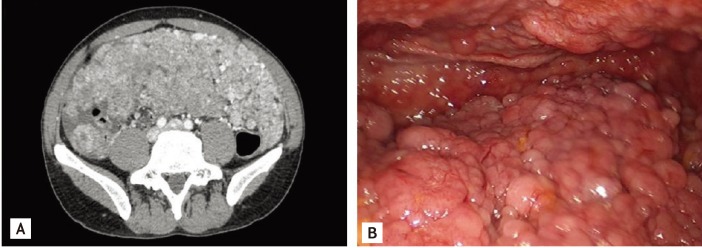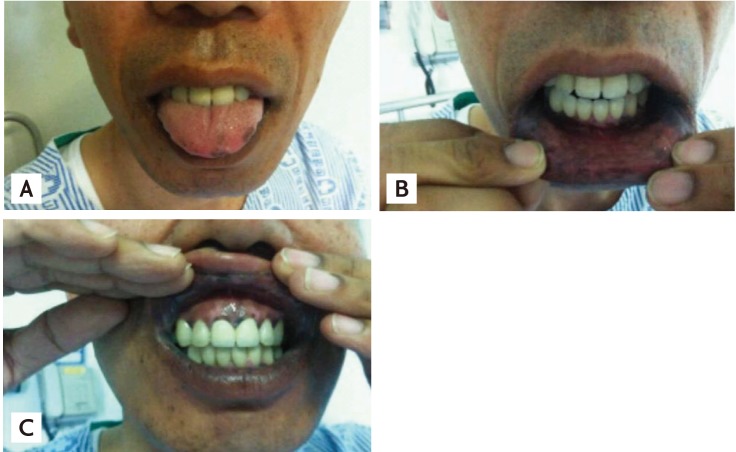Malignant acanthosis nigricans in a patient with a gastrointestinal stromal tumor
Article information
A 45-year-old male presented with a 3-week history of hyperpigmentation of the lip, tongue, and oral cavity (Fig. 1). He had attended an endocrinology outpatient clinic for evaluation of diabetes or adrenal insufficiency. The patient did not have diabetes, but had a 7-year history of hypertension. The endocrinologist diagnosed acanthosis nigricans clinically. On systematic review, the patient stated that he had abdominal distension, discomfort, and easy satiety for several months. He was referred to us for an evaluation of the abdominal discomfort and internal malignancy. Computed tomography of the abdomen and pelvis revealed an enhancing infiltrative mass involving the entire peritoneum in the mid to lower and left upper quadrants of the abdomen and a small amount of ascites in the perihepatic space extending into the right paracolic gutter and pelvic cavity. This suggested a peritoneal carcinomatosis-like malignancy involving the peritoneum, such as peritoneal mesothelioma diffuse type, lymphoma, or desmoplastic small round cell tumor (Fig. 2A). A peritoneoscopic biopsy showed diffuse scattered nodules up to 1 cm on the viscer omentum (Fig. 2B). These bled readily on touch. Histological and immunohistochemical analyses of the biopsy specimen showed diffusely c-kit-positive epithelioid cells, which are consistent with a malignant gastrointestinal stromal tumor (GIST) (Fig. 3). After diagnosing a GIST, we planned palliative chemotherapy with imatinib as it was inoperable. However, the patient was lost to follow-up.

(A) Computed tomography scans of abdominopelvis revealed that enhancing infiltrative mass lesion replacement whole peritoneum in mid to lower and left upper quadrant of abdomen, small amount of combined ascites along perihepatic space extending into right paracolic gutter and pelvic cavity. (B) On peritoneoscopic finding, there was diffuse scatterd up to 1 cm sized nodular masses on visceral and parietal peritoneum and omentum.

Biopsy specimen showed round to oval shaped epithelioid cells with diffuse positive to c-kit, which were consistent with a malignant gastrointestinal stromal tumor (A, H&E, × 400; B, c-kit, × 400).
Acanthosis nigricans is a paraneoplastic dermatosis characterized by velvety, hyperpigmented plaques on the skin in body folds, typically the armpits, groin, and neck. Sometimes the lips, palms, or soles are affected. Malignant acanthosis nigricans is associated with various neoplasms, most often gastrointestinal adenocarcinoma. The association of this condition with sarcoma is extremely rare. Here, we report acanthosis nigricans on the lip and oral mucous membrane in a patient with GIST. To our knowledge, this is the first case of acanthosis nigricans associated with a malignant GIST.
Notes
No potential conflict of interest relevant to this article is reported.
